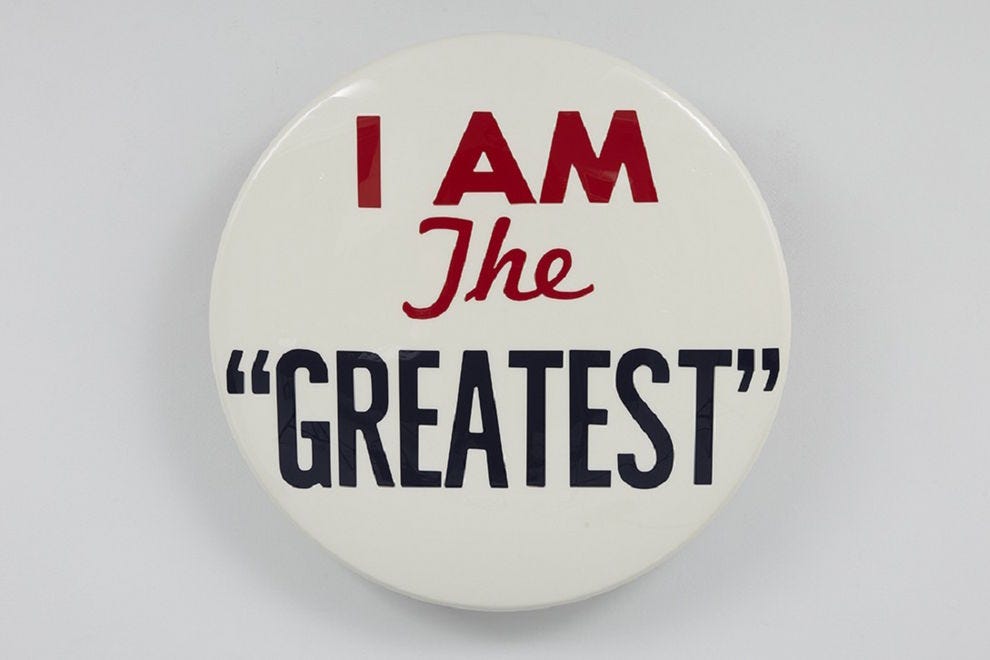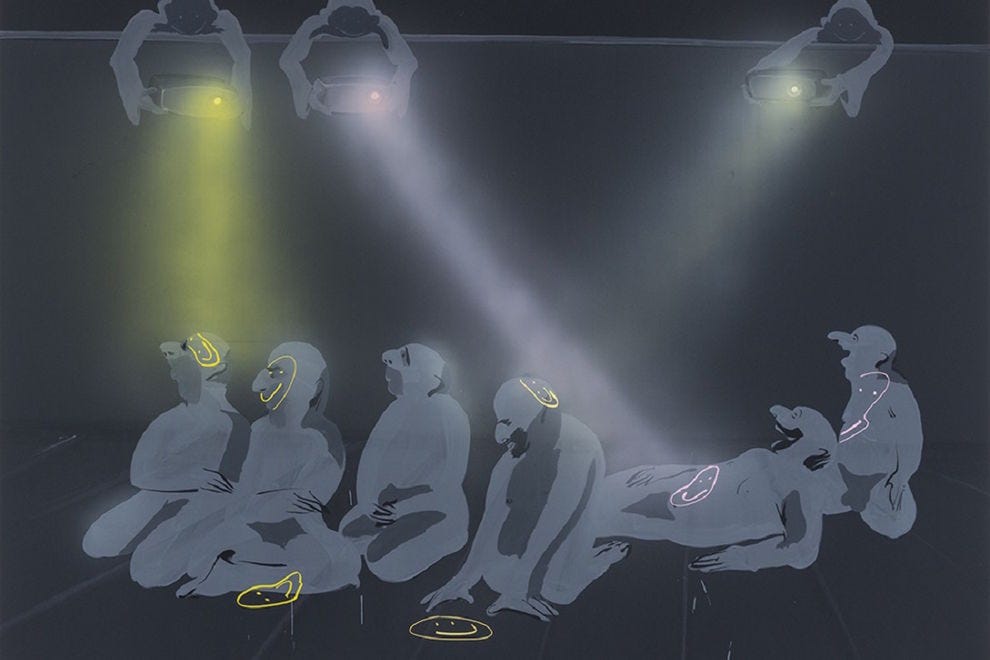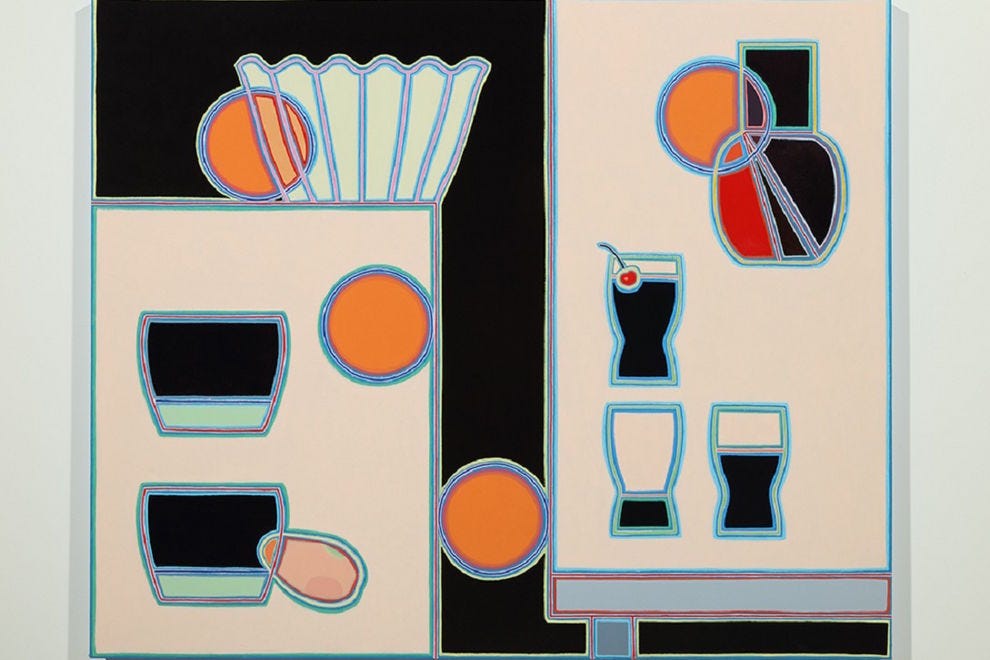Georgette und Landschaft, 2013, Oil, vinyl, pigment marker and varnish on canvas”>One of the many pieces of art in the Alfond Inn: Thomas Scheibitz (German, b. 1968), Georgette und Landschaft, 2013, Oil, vinyl, pigment marker and varnish on canvas — Photo courtesy of Cornell Fine Arts Museum
Hospitality may be an art, but art is also a major part of the hospitality at the Alfond Inn in Orlando.
This luxury boutique hotel has a casual elegance that’s so warm and welcoming, thanks to the eclectic art that greets you at every turn.
What differentiates the Alfond Inn from other art hotels, though – besides the fact that its proceeds provide scholarships to students at Rollins College, whose notable alumni include Mr. Rogers – is that the collection belongs to an academic art museum: the Cornell Fine Arts Museum at Rollins. It was conceived to embody and reflect the museum’s teaching mission.
“We often refer to the collection as a visual syllabus,” says Ena Heller, PhD, Bruce A. Beal Director, Cornell Fine Arts Museum, Rollins College. “Its emphasis on critical thinking, literacy, multicultural dialogue and self-reflection paired with understanding the traditions and perspectives of others, is aligned with the ethos of a liberal arts education.”
The collection currently includes more than 400 works of contemporary art, from which the Inn draws its rotating installations. Guests can take free guided tours, which are open to the public, and audio tours are also available. Self-guided tours are a real option, thanks to descriptive labeling next to each piece.
“There is something about experiencing art outside of the walls of a museum that makes it more approachable, less intimidating,” says Dr. Heller.
Here’s a mini tour by Dr. Heller of 10 pieces you’ll want to check out in person:
Citoyen du Monde by Meschac Gaba
 Meschac Gaba (Beninese, b. 1961, Citoyen du Monde, 2012, Inkjet print on synthetic canvas — Photo courtesy of Cornell Fine Arts Museum
Meschac Gaba (Beninese, b. 1961, Citoyen du Monde, 2012, Inkjet print on synthetic canvas — Photo courtesy of Cornell Fine Arts Museum
Meschac Gaba, who shares his time between his birthplace of Benin, West Africa and the Netherlands, explores cultural identity and themes of globalization, capitalism, ecology and migration.
Citoyen du Monde (“Citizen of the World”) is his vision for a global flag. Made of the flags of every single country, it imagines a harmonious coming together of all the peoples and cultures of the world. The immense flag is created by elongating individual flags into narrow triangles that converge at the central point.
Optically spectacular, the singularity of each flag is lost in the rhythm of the composition.
I am the Greatest by Hank Willis Thomas
 Hank Willis Thomas (American, b. 1976), I am the Greatest, 2012, Mixed media — Photo courtesy of Cornell Fine Arts Museum
Hank Willis Thomas (American, b. 1976), I am the Greatest, 2012, Mixed media — Photo courtesy of Cornell Fine Arts Museum
This work is an enlarged reproduction of a pin-back button from the 1970s, featuring the iconic quote from boxer Muhammad Ali, who took center stage in the realms of sports, popular culture and political activism.
Hank Willis Thomas is a conceptual artist whose work employs the visual language and terminology of mass media, and appropriates symbols and images from popular culture to question and subvert existing narratives of race and personal identity. Ali’s words challenge notions of white supremacy by claiming one’s humanity, worth, and greatness in the public sphere.
Cloud Cities – Nebulous Thresholds by Tomas Saraceno
 Tomás Saraceno (Argentinian, b. 1973) Cloud Cities – Nebulous Thresholds, 2017 Metal, polyester rope, fishing line, iridescent plexiglass, metal wire, steel thread — Photo courtesy of Cornell Fine Arts Museum
Tomás Saraceno (Argentinian, b. 1973) Cloud Cities – Nebulous Thresholds, 2017 Metal, polyester rope, fishing line, iridescent plexiglass, metal wire, steel thread — Photo courtesy of Cornell Fine Arts Museum
A commission for the Rollins collection, this work is part of a series exploring utopian habitats and transnational cities in the sky. Asked why so many of his sculptures hang from above, the artist noted, “I love the idea of flying in the air with your feet on the ground.”
Tomas Saraceno was trained as an architect, and always displays a scientific mind and curiosity. This is part of one of his most significant bodies of work, Cloud Cities, a series of indoor and outdoor installations grounded in scientific research, engaging us in a dialogue about the potential of permanent dwellings in the sky: Are they possible? Would they make us connect with one another better? What would they teach us?
Light is one of the essential ingredients of this sculpture, whose color and materiality change drastically at different times of day due to the way they reflect and refract light.
Cakes by Sharon Core
 Sharon Core (American, b. 1965), Cakes, 2004, C-print — Photo courtesy of Cornell Fine Arts Museum
Sharon Core (American, b. 1965), Cakes, 2004, C-print — Photo courtesy of Cornell Fine Arts Museum
This is a work about appropriation and reinterpretation, and is part of a series for which Core drew inspiration from mid-20th century paintings by Wayne Thiebaud. This is from his 1963 painting also titled Cakes.
Starting with a photograph of the painting, Core baked, decorated and arranged the cakes, recreating them in a different light and perspective. She then photographed her set, bringing it back to two dimensions. Her work is less a replica of Thiebaud’s than a transformative interpretation, as the cakes are transformed, for a second time, into a representation.
Projections by Tala Madani
 Tala Madani (Iranian, b. 1981), Projections, 2015, Oil on linen — Photo courtesy of Cornell Fine Arts Museum
Tala Madani (Iranian, b. 1981), Projections, 2015, Oil on linen — Photo courtesy of Cornell Fine Arts Museum
Tala Madani is known for paintings that look incisively and often irreverently at Middle Eastern culture and gender issues. Influenced by pop culture, they’re both funny and serious, charming and unsettling.
As a child in Tehran, her grandfather would take her to Mellat Park, one of the city’s largest green spaces, full of shopkeepers and merchants and businessmen who gathered there every morning. That’s when she became fascinated with “the secret life of men,” and it’s why all her figures are male.
Numbers and Trees, Central Park, Series I: Tree #1, Ben by Charles Gaines
 Charles Gaines (American, b. 1944), Numbers and Trees, Central Park, Series I: Tree #1, Ben, 2015 Acrylic, inkjet print, Plexiglass — Photo courtesy of Cornell Fine Arts Museum
Charles Gaines (American, b. 1944), Numbers and Trees, Central Park, Series I: Tree #1, Ben, 2015 Acrylic, inkjet print, Plexiglass — Photo courtesy of Cornell Fine Arts Museum
Charles Gaines’ work explores relationships between language, systems and aesthetics.
Here, he superimposes a plexiglass box frame on a three-part black-and-white photograph of a tree from Central Park, with a single tree in the foreground. He maps the shape of the foreground tree onto a grid sequence by painting and numbering each cell, centering the base of the trunk at zero.
Two Tables, Oranges, Cherry Cola by Holly Coulis
 Holly Coulis (Canadian, b. 1968), Two Tables, Oranges, Cherry Cola, 2017, Oil on linen — Photo courtesy of Cornell Fine Arts Museum
Holly Coulis (Canadian, b. 1968), Two Tables, Oranges, Cherry Cola, 2017, Oil on linen — Photo courtesy of Cornell Fine Arts Museum
A 21st-century interpretation of the still life, this piece is characteristic of the artist’s clarity of form and her preference for broad areas of color with hard-edge construction.
Holly Coulis’ process in this composition begins with the painted background and proceeds with a rough design made with painted lines. She then develops shapes and reinforces the lines of the design by painting over them. Thus, the edges of the glasses and fruit reflect the full shape underneath, and the colored edges are, in fact, fully painted forms in lower levels of the surface. Each form, whether negative of positive space, is edged by at least two colors.
No Number 3 [warm white, large version] by Joseph Kosuth
![Joseph Kosuth (American, b. 1945), <em>‘No Number 3’ [warm white, large version]</em>, 1991, Warm white neon”><span class=](https://img1.10bestmedia.com/Images/Photos/364793/Alfond-Inn-2_54_990x660.jpg) Joseph Kosuth (American, b. 1945), ‘No Number 3’ [warm white, large version], 1991, Warm white neon — Photo courtesy of Cornell Fine Arts Museum
Joseph Kosuth (American, b. 1945), ‘No Number 3’ [warm white, large version], 1991, Warm white neon — Photo courtesy of Cornell Fine Arts Museum
This neon work from one of the pioneers of conceptual art is installed over the check-in desk to welcome guests as they enter the Alfond Inn.
Starting from the premise that traditional art was no longer relevant for a world experiencing profound social and political upheavals, conceptual artists in the 1960s and 70s proposed that the sole defining feature of a work of art is not its physical makeup but the idea behind it.
“Language must speak for itself” plays on the cliché that art speaks for itself yet proposes more questions than provides answers.
Walker Evans: Floyd Burroughs and Tengle children, Hale County, Alabama by Francis Ruyter
 Francis Ruyter (American b. 1968), Walker Evans: Floyd Burroughs and Tengle children, Hale County, Alabama, 2011, Acrylic on canvas — Photo courtesy of Cornell Fine Arts Museum
Francis Ruyter (American b. 1968), Walker Evans: Floyd Burroughs and Tengle children, Hale County, Alabama, 2011, Acrylic on canvas — Photo courtesy of Cornell Fine Arts Museum
This is another work illustrating appropriation in contemporary art, transforming a Walker Evans black-and-white photograph of Floyd Burroughs with the Tengle children into a painting.
The photograph – part of the effort funded by the Farm Security Administration between 1935 and 1944 to document the plight of the American poor – was taken by Evans while documenting Southern tenant farmers in 1936. Ruyter transforms this and other Depression-era photographs into paintings; according to the artist, these photographs transcend their original propaganda functions, having become “the material of American identity.”
Here, he takes the figures out of the original impoverished home and employs abstract form and color to bring them into the present.
Second Family – Triangle by Monir Farmanfarmaian
 Monir Farmanfarmaian (Iranian b. 1924), Second Family –Triangle, 2011, Mirror, reverse-glass painting, and plaster on wood — Photo courtesy of Cornell Fine Arts Museum
Monir Farmanfarmaian (Iranian b. 1924), Second Family –Triangle, 2011, Mirror, reverse-glass painting, and plaster on wood — Photo courtesy of Cornell Fine Arts Museum
Born in Iran, Monir Farmanfarmaian’s art is inspired by and reflective of traditional Islamic design, as exemplified by the triangle.
This piece, with its intricately patterned and geometric mirrored mosaics, is a series of 19 triangles dissecting the triangular encompassing form, resulting in a complex design that guides the eye in a spiraling motion. The mirror mosaic technique was influenced by a visit the artist made in 1966 to the 14th century Shrine of Shah Cheragh.
The attention to architectural form, the use of mathematical precision, the reference to culture and use of mirrors are all characteristic of her work.
